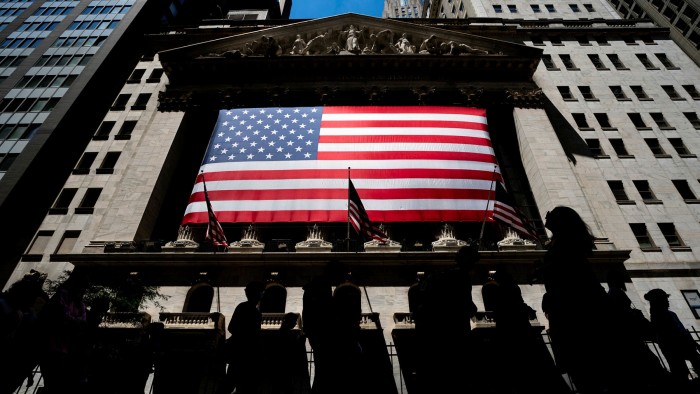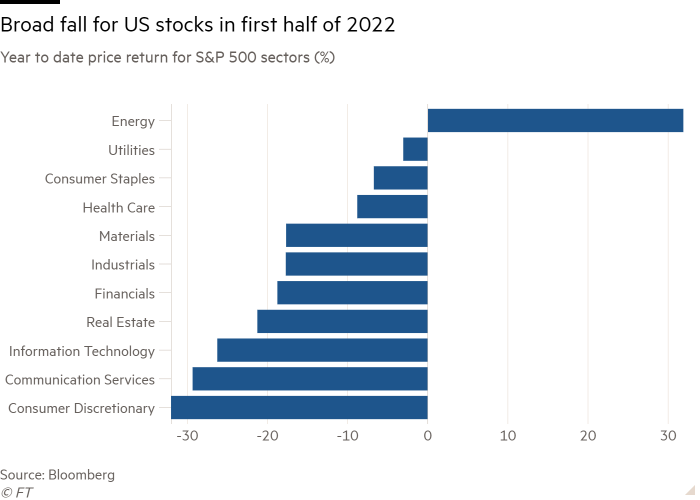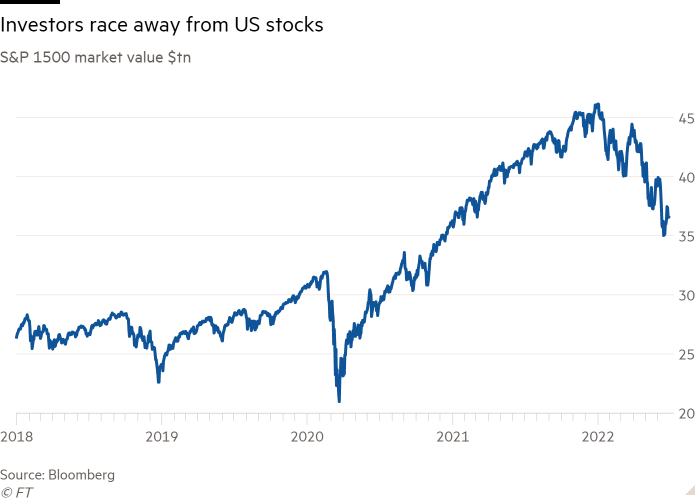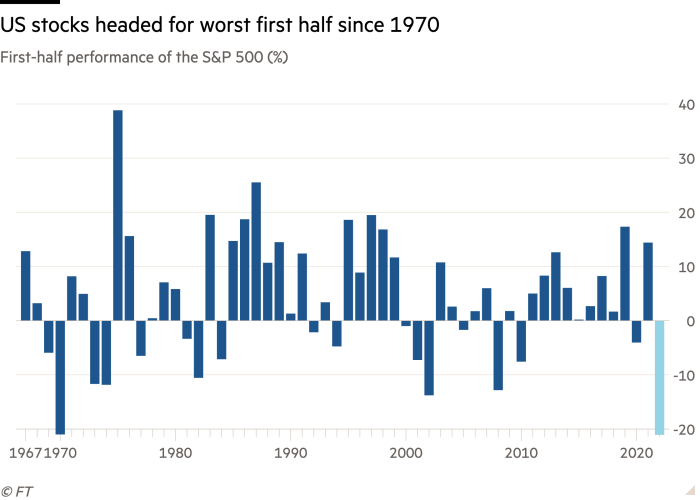US stocks suffer sharpest first-half drop in more than 50 years

Simply sign up to the Equities myFT Digest -- delivered directly to your inbox.
US stocks have recorded their worst first half in more than 50 years after a rout triggered by the Federal Reserve’s attempt to curb persistent inflation and exacerbated by gathering concerns over global growth.
The S&P 500 fell 0.9 per cent on Thursday, leaving the blue-chip index down by 20.6 per cent in the first six months of 2022. Wall Street equities have not endured such a punishing start to a year since 1970, when equities sold off in response to a recession that ended what was up to that point the longest period of economic expansion in American history.
The pullback in US stocks has eviscerated more than $9tn in market value since the end of 2021, according to Bloomberg data on the S&P 1500 index, a broader gauge which tracks small, mid and large-cap groups.
“The market mood is dominated by the possibility of recessions in the US and Europe,” said Bastien Drut, strategist at Paris-based asset manager CPR. “It is very negative,” he added, warning that the days of being able to rely on central banks easing monetary policy to support economic growth were “gone”.
The technology-heavy Nasdaq Composite has also tumbled this year, sliding 1.3 per cent on Thursday to take its losses in 2022 to almost 30 per cent.

All sectors of the S&P 500 have dropped during the half-year, with the exception of energy stocks, which are 29 per cent higher. Consumer discretionary stocks have fallen the most, registering a 33 per cent decline. Utility stocks, seen as an inflation hedge because of companies’ stronger ability to pass higher costs to consumers, have given up the least, down 2 per cent this year.
“Everything has been very inflation-driven,” said Paul Leech, co-head of global equities at Barclays. “It has been the theme of the year and it has just intensified, really.”
Across the globe, big stock indices have fallen sharply. Europe’s Stoxx 600 was 1.5 per cent lower on Thursday, leaving it down about 17 per cent this year. MSCI’s index of Asia-Pacific markets has slumped 18 per cent in 2022 in dollar terms.

Top policymakers at the European Central Bank’s annual conference on Wednesday warned that the era of low interest rates and moderate inflation had come to an end following the inflation shock caused by Russia’s invasion of Ukraine and the coronavirus pandemic.
Fed chair Jay Powell has warned that if the central bank does not raise interest rates high enough to combat inflation quickly, the US could face severe and repeated bouts of price rises that policymakers could struggle to rein in. “The process is highly likely to involve some pain, but the worst pain would be from failing to address this high inflation and allowing it to become persistent,” he added.
Markets have been rattled this month by interest rate rises from the Fed and Bank of England, with the former raising the federal funds rate by 0.75 percentage points to a new target range of 1.5 to 1.75 per cent with policymakers signalling another big rate increase next month.

The ECB is also planning a quarter-percentage point rise in July for the first time since 2011.
“Stubborn inflation readings have precipitated an increasingly hawkish Fed response, tilting the policy focus to fight inflation despite potential economic consequences,” said Scott Chronert, US equity strategist at Citigroup. “Investors are deservedly hesitant to buy ahead of ongoing Fed rate hikes and fear of earnings expectation resets.”
Citi also lowered its year-end forecast for the S&P 500 from 4,700 to 4,200 points on Wednesday. While that new target implies a roughly 11 per cent rise from the benchmark’s current level, economists at the bank also placed the odds of a global recession at 50 per cent.
Comments